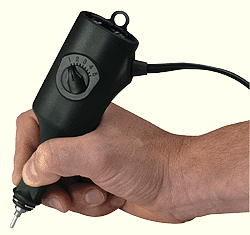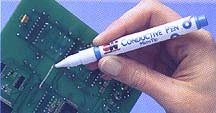Overclocking AMD's Socket Processors
Opening And Closing The Copper Contact Bridges
The next problem we've got to tackle before I'll get to the actual settings is how to open and close those copper bridges on the processors. I received several suggestions, which can be divided into two sections. The one half of my most helpful readers suggested etching the bridges with PCB-etching material.
While this solution might sound most sensible, it produces the problem that the etching agent can hardly be applied to the tiny bridge area only. The very contacts might go away as well, unless you've got top notch masking material. In this case a reversal of this operation could become close to impossible, which is obviously rather dangerous.
The other half of my readers suggested several kinds of micro files or saws, going from dental equipment to optical tools. James D. Flodin came with an excellent suggestion. He pointed me to an electric engraving pencil, as the one shown below (Dremel Electric Engraver):
Finally Robert Kelley thinks that the bridges might be little fuses that can be 'blown' by a low-voltage/high-current without damaging the chip. It sounds possible, but you got to be careful that the voltage stays low (I'd suggest 2-3 V) and you connect tiny electrodes to the two ends of the bridge. Make sure that there's no static voltage on the electrodes!
Thanks for all the suggestions folks!
Closing the bridges is an actual piece of cake. Every electronic engineer will know those conductive silver pens, which can be used to fix little errors on PCBs. Those pens work perfectly to connect the two contacts and the bridge is closed.
Get Tom's Hardware's best news and in-depth reviews, straight to your inbox.
Current page: Opening And Closing The Copper Contact Bridges
Prev Page Can You Figure It Out By Yourself? Next Page Now Here's The Beef - The Voltage And Multiplier Settings
